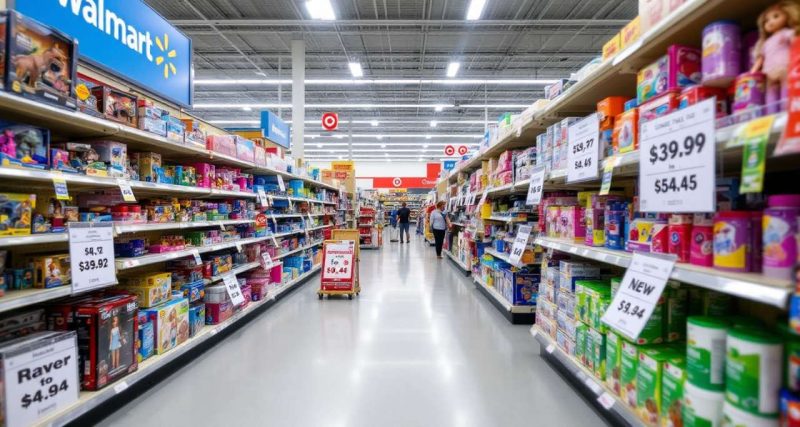The New Price Reality: Tariffs, Retail Giants, and the American Wallet

The Scene at the Register
If you’ve been to a Walmart or Target lately, you might have felt that familiar jolt of disbelief at the checkout. The price of a “Jurassic World” T. rex toy, for example, shot up from $39.92 in late April to $55 by late May—a nearly 38% jump. A “Baby Born” doll leapt from $34.97 to $49.97 in just a few weeks. Even a roll of tape, once $4.24, now rings up at $9.94. These aren’t isolated blips; they’re part of a broader trend that’s hitting American shoppers right where it hurts: their wallets. And while inflation has been the usual suspect for years, this time, tariffs are taking center stage.
The Tariff Tangle: How We Got Here
The story starts with a new round of import tariffs, including a flat 10% on most goods and up to 50% on products from China, Vietnam, and Indonesia. President Trump’s administration imposed these sweeping tariffs in early April, briefly spiking the China rate to 145% before dialing it back to 30% after a public outcry and legal challenges. The intention was to pressure foreign manufacturers and protect American jobs, but the reality is more complicated. As one Target executive put it, “We have many levers to use in mitigating the impact of tariffs, and price is the very last resort.” But when the cost of bananas, avocados, toys, and electronics all go up at the border, those levers only stretch so far.
Walmart: The Reluctant Price Setter
Walmart, the world’s largest retailer, has found itself in the crosshairs. CEO Doug McMillon and CFO John David Rainey have both acknowledged that while the company tries to absorb some of the tariff costs, it simply can’t eat them all. “This is a little bit unprecedented in terms of the speed and magnitude in which the price increases are coming,” Rainey told CNBC. The company’s strategy has been to raise prices selectively, but the impact is visible on shelves and receipts. A fishing reel that cost $57.37 in April now sells for $83.26. Office supplies, toys, and even heating pads have all seen double-digit percentage increases. Walmart’s spokesperson summed it up: “We’ll keep prices as low as we can for as long as we can given the reality of small retail margins”.
Target: Holding the Line—For Now
Target, meanwhile, is trying to walk a tightrope. CEO Brian Cornell has repeatedly called raising prices a “last resort,” and the company has been working overtime to negotiate with suppliers, shift sourcing, and tweak product assortments. But even Target can’t hold back the tide forever. When Walmart raised the price of that Baby Born doll, Target quietly matched it. The company’s financial forecast for the year has been lowered, and while executives are downplaying the scale of tariff-related price hikes, shoppers are already seeing the difference on the shelves.
The Political Theater
All of this is playing out against a backdrop of political drama. President Trump has publicly demanded that retailers “eat the tariffs” rather than pass costs on to consumers, even threatening companies like Mattel with 100% tariffs if they raise prices. But as any retail analyst will tell you, tariffs are paid by U.S. importers, not foreign manufacturers. The pressure on Walmart, Target, and others is real—and so is the risk of alienating both the White House and their customer base.
The Shopper’s Dilemma
For shoppers, the result is a confusing mix of sticker shock and uncertainty. Some items are up sharply, others less so, and a few have disappeared from shelves altogether as retailers quietly drop products that no longer make financial sense. I’ve seen it myself: a favorite brand of coffee suddenly missing, a toy my nephew wanted now out of reach. It’s a reminder that global trade policy isn’t just an abstract debate—it’s something you feel every time you scan your groceries or pick out a birthday present.
What Happens Next?
Retailers are still hoping for relief. A recent federal court ruling blocked most of the new tariffs, but appeals are ongoing and the uncertainty remains. In the meantime, companies are scrambling to diversify supply chains, cut costs, and—when all else fails—raise prices. As one analyst put it, the broader impact on consumer spending may be “just a low-single-digit percentage,” but for families already stretched thin, every dollar counts AOL.
Final Thoughts
The next time you’re at the checkout and wonder why your total is higher than last month, remember: it’s not just inflation. It’s the ripple effect of tariffs, supply chain shifts, and a retail industry caught between political crossfire and economic reality. And while Walmart and Target are doing what they can to shield shoppers, the era of ultra-low prices may be fading—at least for now.
